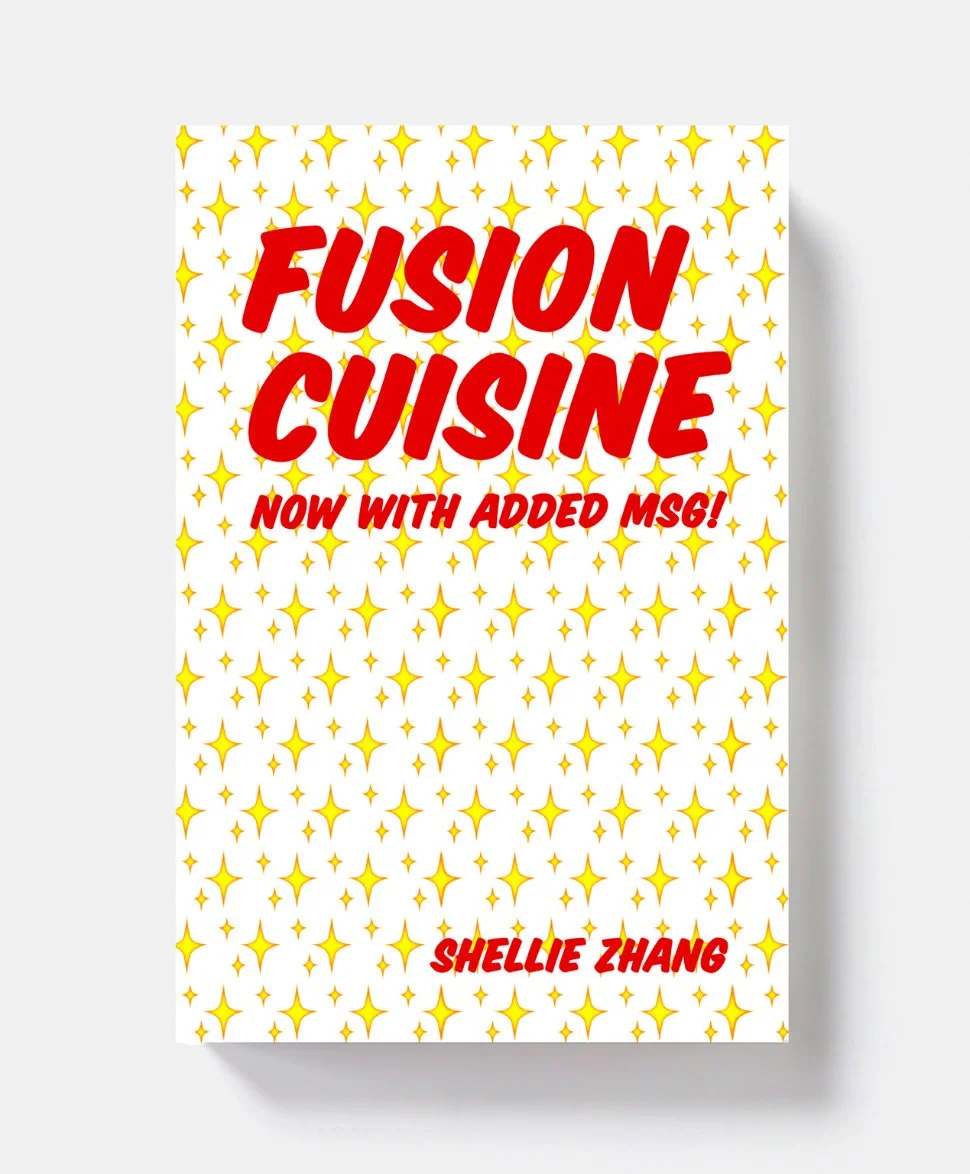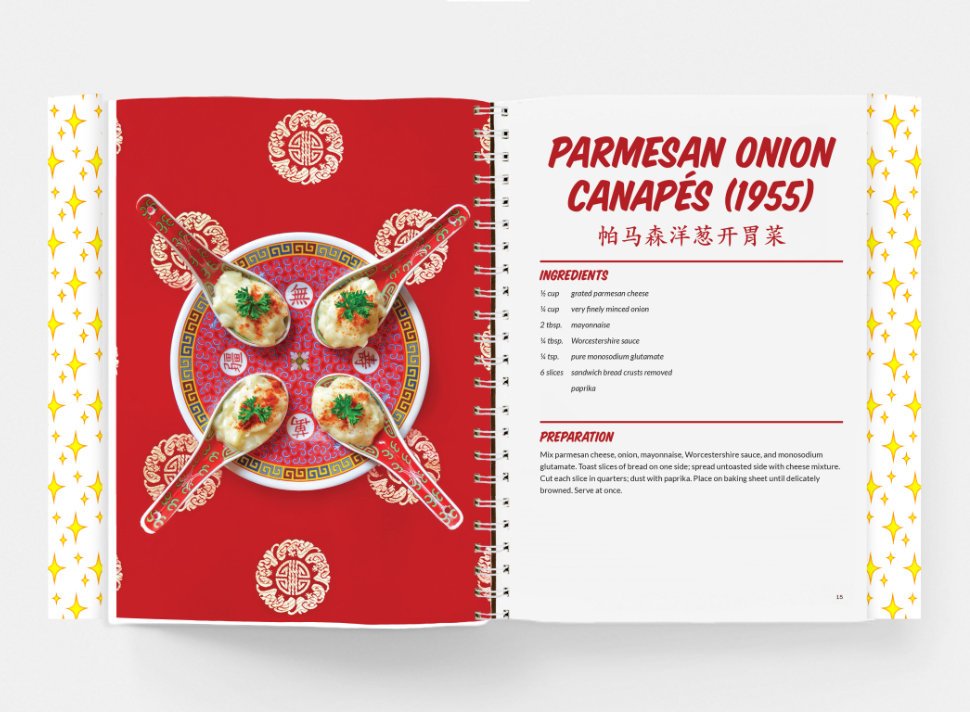FAIR SHAKE
from the Archives
FROM OCTOBER 2018 ISSUE OF WEST END PHOENIX
“Red Canteen” from Shellie Zhang’s solo show titled Aesthetic of Surfaces that ran at the Bradley Museum (Museums of Mississauga) in November 2018.
Shellie Zhang has a thing for MSG. It’s the subject of her book, called Fusion Cuisine, Now with Added MSG! It features a collection of historic “Canadian” recipes from the 1930s to the ’70s that call for the additive, years before it was used to negatively stereotype Asians, and especially Chinese people, through their food. In Fusion Cuisine, the food photography is intentionally exoticized through heavily stylized plating, forcing viewers to consider how food can be racialized. The Parkdalian artist spoke to Chiedza Pasipanodya about the myths behind MSG and why it’s caused trouble
The artist’s book of historical “Canadian” recipes that include MSG in their ingredient list.
Why is food an entry point in so many of your pieces?
I’m from Beijing originally, and being a part of the East Asian diaspora, I almost can’t subtract food from my identity. It’s something that I’ve held onto dearly – partly from being repressed and being made ‘other’ so dramatically and strangely.
We first settled in Baltimore before coming to Canada, and I remember discovering that I was not the norm. There was a necessity to assimilate in those early days through food.
The ‘norm’ was what was served in the cafeteria – things like PB&J sandwiches, which were completely out of this world for me, two completely new substances that [in North America] were taken as a staple food. I ate Lunchables for years even though it wasn’t that nutritious for me, but it was simple, neatly packaged and socially safe.
Now we are kind of at a time when otherness is being embraced and framed in a different way. I’m thinking, for example, of my piece called ‘Red Canteen.’ These floral canteens [see cover image] are dated Communist-age objects that you don’t see here very much. They are often served with hot water in them in Chinese communities. Every time I go overseas, it could be three times hotter outside and I’ll ask for a glass of ice water and people will always look at me like, ‘Oh – you are not from here,’ because to put cold things in your body is considered a negative spiritual and physical practice. I am immediately identified as other. In my work, I’m often interested in usurping that.
From A Visual History of MSG Marketing, 2016–2017.
In the past, you worked on a project called “Accent,” about an MSG brand and its marketing, and more recently you published a cookbook on the subject. Why the fascination with monosodium glutamate?
There’s a Mexican writer, Gustavo Arellano, who said, ‘Humans have always demonized the cuisine of the other because it’s the easiest way to say someone is less human.’ That’s what [my MSG work] addresses.
Ironically, MSG antagonization began in 1968, when a letter to the editor – not a scholarly document – written by a Chinese-American doctor was published in the New England Journal of Medicine. In the letter, he wrote that sometimes when he went to Northern Chinese restaurants, he felt a little sleepy, noticed his heart rate increase and wondered about the cause of this and if it could be frequently used ingredients like soy, cooking wine and MSG that were to blame. When the journal published the letter, they called it The Chinese Restaurant Syndrome. Many readers wrote in expressing how they too had experienced similar reactions, and the blame was laid on MSG. I think this was largely because it sounds scientific and unfamiliar. For example, dihydrogen monoxide is a scientific name for water. I remember years ago a high school student created a project with warnings about the effects of dihydrogen monoxide – it causes rust. Students voted to ban the substance based on the fear it generated.
A page showing the overt styling featured throughout the book.
Fast-forward to a few years ago: I discovered a paper written by Ian Mosby at the University of Guelph, which mentioned how a lot of Canadian recipes used MSG in the past. My first question was, ‘What is a Canadian recipe and where do you find this food?’ His paper directed me to archives of the Toronto Star and there I collected recipes from 1935–1976, [mostly] before the antagonization of MSG. The recipes consisted of really bad post-war foods – a lot of gelatins and fondues and meats with fruit and such – rooted in a newfound [culture of] consumption. During this time, MSG was marketed by a company called Accent as the third shaker in addition to salt and pepper.
Research about pesticides was just beginning to emerge. Silent Spring by Rachel Carson included some of the [earliest] research to expose how bad the pesticides in our food were for us. This really was an interesting moment in history in terms of our notion of food [safety]. Unfortunately, over time it steamrolled and you began to see many East Asian restaurants advertising that they did not have MSG, as if to say, ‘We’re safe, you can trust us.’ The ultimate irony is that MSG is naturally occurring. It’s found in Italian food – MSG is abundant in Parmesan cheese and tomatoes – but of course you don’t see those kinds of restaurants having to make MSG-free declarations. I wanted to explore why this simple substance had taken on such a negative meaning for one group of people’s [cuisine] but not another’s.
“No MSG (In Memory of Lee Garden)” is an homage to a sign that hung in the window of that restaurant, which closed in 2017 after 39 years in business.
How did the book come together?
I made and photographed all of the ‘Canadian’ recipes using the original instructions. I even ate them. But I chose to use an intentionally over-the-top exoticized Chinese style for the plating and backgrounds to challenge the notion that MSG is Chinese, as it is often perceived.
Can you talk about the title?
It came from a feeling that culture, history, class and colonization play a huge role in how food is perceived. For example, when a white chef creates a fusion menu using East Asian cuisine, they’re often thought of as elevating the East Asian [repertoire], of taking it to another level. However, when an East Asian chef tries to do something innovative with the same cuisine, the criticism is often that they’re straying from tradition. There seems to be a food glass ceiling and I wanted to subvert that.
What’s your favourite recipe in the book?
I don’t consider myself a good cook, so my favourite is the easiest one, the Mississauga Fried Chicken. There’s nothing inherently Mississauga about it – it’s just fried chicken. But it was very good and only has five ingredients!
From the artist’s “Accent” series, which explores MSG marketing: a small plastic bag of MSG meant to evoke an illicit substance.
What are some of your favourite places to eat in your neighbourhood?
I love Loga’s. He makes Tibetan momos. He also makes his own phenomenal hot sauce. Another place I love is Island Foods on King Street. They are right by my corner. There is no other place I would wait in line at 5 p.m. for food, but at Island Foods, it’s worth it. And sometimes when it’s really late I go to the McDonald’s at the corner of King and Dufferin.
What’s your all-time favourite food?
I love ice cream. It’s one of the simplest, purest joys left in the world and, like the dumpling, there is a version of it across all cultures. Instead of the traditional wine tour of the world, I would like to do an ice cream tour. One of my recent favourite ice cream places is Ruru Baked [they sells pints at Empire Espresso at College and Beatrice], run by a woman who started out making small-batch ice creams by herself and delivering them. I once had one with a seaweed seasoning on top. It seems kind of bizarre but resembled salted caramel in taste. I think ice cream is pretty exciting. If art doesn’t work out, I’m going to make ice cream.







